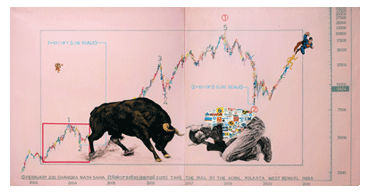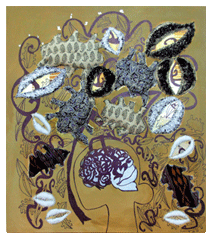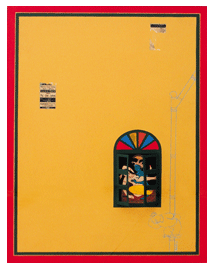- Prelude
- Hard Talk
- New Media
- Rolex : An Overview
- The age of Revivals: Neoclassical Furniture
- Democratization of the Medium No-Budget film: the Indian Context (!)
- Old Sound New Sound
- Decan Odyssey
- North East Opsis
- Russian cool breeze in hot Paris
- Around Kolkata
- Musings from Chennai
- In and around Santiniketan
- In between – from Vadodra
- A Tryst with Art in Madhya Pradesh
- Through the Looking Glass
- The Foreign Connection
- Market Insight
- Market Report
- Artist Index and Statistics
- Auction Reports
- The month that was
- Delhi Dias
- Art Bengaluru
- Mumbai Art Sighting
- Creative Impulse
- Subodh Gupta
- Pooja Iranna
- Preview
- In the News
ART news & views
Around Kolkata
Volume: 2 Issue No: 9 Month: 10 Year: 2010
Young & Upcoming
Chandra Nath Saha
 Tilak has done his M.V.A from Government College of Art & Craft in 2008. According to him, the city life offers a great variety of elements but the things which appeal to him the most are the advertisements which are seen in plenty in any part of the city. People are brand conscious when they see the different advertising. All these elements are present in his works where he shows the urban life of the people. The works are figurative and exude the true urban feel. The thought process of the artist is constantly influenced by the colourful sign boards and hoardings. According to the artist, all these elements are disturbing to the human eyes, but at the same time their impact is also powerful. The instinct inside the artist wants to be like the persons or faces as seen in the advertisements wearing all branded item. His works revolve around these vibrant things and with the passage of time, he identifies himself as one of the persons as portrayed in the hoardings. Besides painting, Tilak wants to explore the new mediums by doing installations and using the gallery space as much as possible. Nature has never been his subject of interest as he stays in the city and what he paints is the reflection of fast urban life. Medium is no bar to him, he paints with acrylic on canvas but does not want to confine himself within the canvas. He thinks art can never be defined in one medium. If given a chance to showcase his ideas and works, he wants to hire the backlit advertising vans and put his paintings on them so that the city can see his works. Tilak thinks, if one is serious towards his work, then fame will come to him but with time.
Tilak has done his M.V.A from Government College of Art & Craft in 2008. According to him, the city life offers a great variety of elements but the things which appeal to him the most are the advertisements which are seen in plenty in any part of the city. People are brand conscious when they see the different advertising. All these elements are present in his works where he shows the urban life of the people. The works are figurative and exude the true urban feel. The thought process of the artist is constantly influenced by the colourful sign boards and hoardings. According to the artist, all these elements are disturbing to the human eyes, but at the same time their impact is also powerful. The instinct inside the artist wants to be like the persons or faces as seen in the advertisements wearing all branded item. His works revolve around these vibrant things and with the passage of time, he identifies himself as one of the persons as portrayed in the hoardings. Besides painting, Tilak wants to explore the new mediums by doing installations and using the gallery space as much as possible. Nature has never been his subject of interest as he stays in the city and what he paints is the reflection of fast urban life. Medium is no bar to him, he paints with acrylic on canvas but does not want to confine himself within the canvas. He thinks art can never be defined in one medium. If given a chance to showcase his ideas and works, he wants to hire the backlit advertising vans and put his paintings on them so that the city can see his works. Tilak thinks, if one is serious towards his work, then fame will come to him but with time. Tisha Mondal
 Tisha practiced drawing despite being a sculptor. She used to work in two dimensional forms, but with time her works got transformed which according to her is natural. The kind of sculptures she does can be termed as soft sculptures but that is not the only way she wants to execute her creativity. Loneliness played a very important role in her life with special reference to lizards. During her stay in Santiniketan, she was alone and used to observe the nature which is highly reflected in her works. Tisha believes in simplicity and wants her works to bear the same. The execution is very important to her and she always tries to keep it simple. Her works are reflections of her surroundings, her life, her personal traits and that are the most important factors of her works as she claims. The surroundings can comprise of nature, people, society, politics or the every day trivial happenings. Tisha wanted herself to be conceptually strong and she has transformed with time. Her works also bear the same testimony. The earlier works of her were more impulsive but now she spends a lot of time in conceptualizing and constructing the concept. Desire, according to her is the most predominant factor in her works. She thinks that desire can be defined in any way which varies from person to person. According to her, it can be sexuality, it can be happiness, it can be despair, it can be obsession about creating something which may not be perceptible to everybody, but to her it is the most important thing. She wants to show this desire to the viewers of her works.
Tisha practiced drawing despite being a sculptor. She used to work in two dimensional forms, but with time her works got transformed which according to her is natural. The kind of sculptures she does can be termed as soft sculptures but that is not the only way she wants to execute her creativity. Loneliness played a very important role in her life with special reference to lizards. During her stay in Santiniketan, she was alone and used to observe the nature which is highly reflected in her works. Tisha believes in simplicity and wants her works to bear the same. The execution is very important to her and she always tries to keep it simple. Her works are reflections of her surroundings, her life, her personal traits and that are the most important factors of her works as she claims. The surroundings can comprise of nature, people, society, politics or the every day trivial happenings. Tisha wanted herself to be conceptually strong and she has transformed with time. Her works also bear the same testimony. The earlier works of her were more impulsive but now she spends a lot of time in conceptualizing and constructing the concept. Desire, according to her is the most predominant factor in her works. She thinks that desire can be defined in any way which varies from person to person. According to her, it can be sexuality, it can be happiness, it can be despair, it can be obsession about creating something which may not be perceptible to everybody, but to her it is the most important thing. She wants to show this desire to the viewers of her works. Sayak Mitra
 Sayak is a self taught artist with a degree in engineering. Creativity comes to him naturally as he explores the various aspects of the society. He is more comfortable with the graphics form but does not want to define his creativity within that sector only. Sayak has been trained under some of the prominent figures in the art circuit of Bengal. His works represent an all encompassing view of the society. He declines to call himself politically biased but he is quite informed about the happenings in and around Kolkata. The comfort factor lies in the fact that he can express himself not in mainstream painting or sculpture but in digital painting. As ordinary citizens of the city we sometimes miss a number of facts but Sayak emphasizes them in his works. May be his works are digitalized but his consciousness get reflected in his works. The violence, the atrocities are the most common factors in his work. Children form an indispensable part of his works. To face the social issues, he is not scared of that, he is ready to combat the pressing issues of the present day world. Being a professional in the field of graphic designing, Sayak creates his own world with his works. He thinks that medium is no constraint in the field of art and he has the will of exploring the various mediums. Sayak is very much aware of the social happenings in and around him and he wants to showcase them in his works.
Sayak is a self taught artist with a degree in engineering. Creativity comes to him naturally as he explores the various aspects of the society. He is more comfortable with the graphics form but does not want to define his creativity within that sector only. Sayak has been trained under some of the prominent figures in the art circuit of Bengal. His works represent an all encompassing view of the society. He declines to call himself politically biased but he is quite informed about the happenings in and around Kolkata. The comfort factor lies in the fact that he can express himself not in mainstream painting or sculpture but in digital painting. As ordinary citizens of the city we sometimes miss a number of facts but Sayak emphasizes them in his works. May be his works are digitalized but his consciousness get reflected in his works. The violence, the atrocities are the most common factors in his work. Children form an indispensable part of his works. To face the social issues, he is not scared of that, he is ready to combat the pressing issues of the present day world. Being a professional in the field of graphic designing, Sayak creates his own world with his works. He thinks that medium is no constraint in the field of art and he has the will of exploring the various mediums. Sayak is very much aware of the social happenings in and around him and he wants to showcase them in his works. Meenakshi Sengupta
 Meenakshi, a student of Govt. Art College was in search of a language, a language she could identify with and feel comfortable to execute. When she entered art college like many of her fellow students she had no idea what she wanted to do. Which line should she take. She found herself studying Indian style painting. Soon the excitement died down as she was tied within a rigid curriculum. From her frustrations rose an idea. She took the rigid and transformed it into something dynamic. In her curriculum she had studied intensively the Indian mythology. She realized as she went deep into the subject that in contemporary times the idea of mythology is constantly changing. New myths are getting created. In her works she explores these possibilities to find out how she can capture these new myths and create a social document. Her style gets generated from her rigorous training but her content comes from what she sees and feels from her surroundings. Her work captures the human psychology, the perversions of mind created by the social limitations. But somehow she manages to remain impersonal. Her story it seems is always from a third person view. Through her work she bounces back the reflection of the viewer compelling him/her to reflect upon their own psychology and morals. She asks the questions expecting not an answer but a chain of reasoning in the viewers mind which would lead to some sort of change in their morals. Meenakshi's work resonate the changing morals of the society and the juxtaposition of the old and the contemporary signs and symbol justifies the primary intention behind her art.
Meenakshi, a student of Govt. Art College was in search of a language, a language she could identify with and feel comfortable to execute. When she entered art college like many of her fellow students she had no idea what she wanted to do. Which line should she take. She found herself studying Indian style painting. Soon the excitement died down as she was tied within a rigid curriculum. From her frustrations rose an idea. She took the rigid and transformed it into something dynamic. In her curriculum she had studied intensively the Indian mythology. She realized as she went deep into the subject that in contemporary times the idea of mythology is constantly changing. New myths are getting created. In her works she explores these possibilities to find out how she can capture these new myths and create a social document. Her style gets generated from her rigorous training but her content comes from what she sees and feels from her surroundings. Her work captures the human psychology, the perversions of mind created by the social limitations. But somehow she manages to remain impersonal. Her story it seems is always from a third person view. Through her work she bounces back the reflection of the viewer compelling him/her to reflect upon their own psychology and morals. She asks the questions expecting not an answer but a chain of reasoning in the viewers mind which would lead to some sort of change in their morals. Meenakshi's work resonate the changing morals of the society and the juxtaposition of the old and the contemporary signs and symbol justifies the primary intention behind her art. Mithun Dasgupta
 Coming from a humble background Mithun found his solace in painting as he struggled to establish his existence. He is extremely sensitive to the evolving society which has imprinted the good and the evil in his mind. His quest is to capture the spontaneity of his dynamic surroundings. Mithun attempts to recognize the layers that has accumulated over the known-unknown faces that he encounters everyday. He has an interesting concept to share. The concealed identity of the society's stock characters and the levels of concealment is what he studies and expresses with great enthusiasm. His actual canvas can be of any size depending upon his earnings but his mind's canvas is immense and is cluttered with images. He has no plan when he starts to work but piles the images one upon the other as they come rushing into his perception. Soon the canvas takes shape. Mithun's disciplined academic learning balances the chaos of the content. But what is unique is how Mithun blends his imagination with the reality he faces. He observes what happens; he doesn't try to analyze the unnecessary inner meanings thus saving himself and his art from the hypocrisy that he himself loves to satirize.
Coming from a humble background Mithun found his solace in painting as he struggled to establish his existence. He is extremely sensitive to the evolving society which has imprinted the good and the evil in his mind. His quest is to capture the spontaneity of his dynamic surroundings. Mithun attempts to recognize the layers that has accumulated over the known-unknown faces that he encounters everyday. He has an interesting concept to share. The concealed identity of the society's stock characters and the levels of concealment is what he studies and expresses with great enthusiasm. His actual canvas can be of any size depending upon his earnings but his mind's canvas is immense and is cluttered with images. He has no plan when he starts to work but piles the images one upon the other as they come rushing into his perception. Soon the canvas takes shape. Mithun's disciplined academic learning balances the chaos of the content. But what is unique is how Mithun blends his imagination with the reality he faces. He observes what happens; he doesn't try to analyze the unnecessary inner meanings thus saving himself and his art from the hypocrisy that he himself loves to satirize.
Sharanya Chattopadhyay